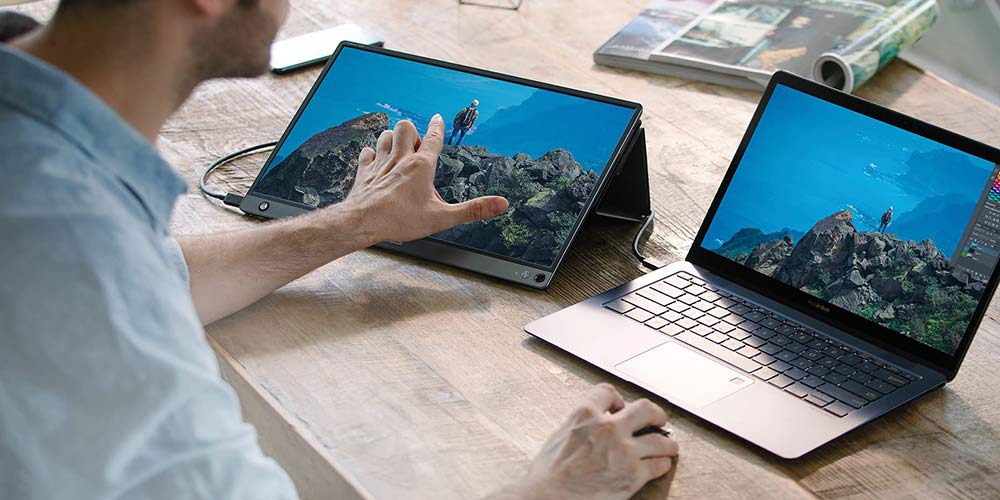
Portable Monitors – The Best of 2022
Portable Monitors – Portable displays that you pair up with a laptop aren’t current phenomena.
However, they have got into their own within the past few years.
Many important monitor manufacturers have a minimum number of monitors in their range.
Newer models appear more regularly than ever.
It is possible to view two programs open full-screen directly.
You can enhance your portable gaming system. Designs with a stylus, mobile monitors of varied sizes, and paradigms are ready to serve.
Portable Monitors – Why all of those panels?
The extensive adoption of the USB Type-C connectivity thru its capability to transfer the data and power.
They do not need a unique dedicated AC adapter for juice though some do include one as an option.
Lots have just one USB-C port that handles all connectivity, although certain people add HDMI or additional connectors.
Portable Monitors – What Qualifies as a transportable Monitor?
Even those range quite a bit in size.
They can range from 3.5 inches to 22 inches.
All of the portable displays that run the range from business, personal, and general use models to the panels for all kinds of gamers and artists.
On the market, there could be a few models at 10 inches.
They are mainly used with gaming consoles and, at 7 inches, used alongside Raspberry Pi.
Most portable displays use a stand consistent with a slim but stiff plastic board.
It comes with several grooves or creases on which it folds.
At one end may be a magnetic strip, which adheres to the monitor’s rear at its top.
They generally fold it in the middle, pointing the angle far from the user, and propping up the monitor.
The underside of the monitor inserts into a groove, securing it and tilting the device upward.
Some portable displays have several grooves, and you’ll alter the monitor’s angle by placing the bottom in a different position.
Portable Monitors –
These stands that fold frequently double up as protective covers for the display to protect it when it’s not in use.
Another stand design that we’ve seen consists of a rigid, flat base containing the ports to which the screen is attached using hinges.
You’ll be able to set the screen to whatever angle you prefer just by tilting it.
However, this type is far less common in any case.
Also, some designs use the laptop itself as the direct support, fastening to its back or side and sliding or swinging out while in use.
They’re small and lightweight enough that they’re easy to regulate manually.
Some monitors may be pivoted by hand, though not all stands can support a monitor in portrait mode.
Therefore, you may always shore up the monitor against a wall or other fixed surfaces in those cases.
Most portable monitors can automatically correct the image, which is always right side up, whether you’re in landscape or portrait mode.
Even in those who lack such automatic image rotation, you’ll be able to change the orientation in Windows display settings.
Portable Monitors: Evaluating the Screen
When we observe the panels for mobile monitors, there are factors to be evaluated.
Because of the laptop screen, many users opt to use a mobile monitor with identical screen size and native resolution.
Finally, we have found that these panels are forgiving and don’t have any trouble running portable displays.
Even though, they might be slightly larger than a standard laptop’s screen.
Portable screens will generally be dimmer than desktops’ most outstanding brightness levels.
What is commonly referred to as brightness is luminance or brightness per unit area.
Portable Monitors – Power and Connectivity
As insinuated earlier, the versatile mobile monitor world is going through an assembly of power and connectivity due to USB Type-C connectivity.
Numerous USB-C ports support both Display Port over USB and USB power conveyance.
That allows the two information/video and power to move through the port from a PC over a solitary USB link.
Most new versatile mobile monitors have around one USB-C port and some associate exclusively through USB-C.
While this facility has its allure, ensure that your laptop’s USB-C port backs data, video, and power move, since some early generation USB-C ports don’t.
A couple of more established compact portable display models draw their power from a Laptop over a different USB 3.0 association.
However, USB-C is well headed to making this sort of association antiquated.
Portable Monitors -The Best of 2022 final thoughts.
Portable Monitors Software, the Onscreen Display, and Audio
Practically all portable displays are fit and play without requiring a software product to allow them to work.
For the most part, any utilities offered, provided on disc and additionally through download, will be for explicit capacities.
An example of this will be the capacity to empower the screen picture to stay upstanding when you switch between landscape and portrait direction.
In some cases, the presentation might accompany a utility that allows you to change screen settings from your PC screen.
On the other hand, it’s the opposite through the auxiliary board’s onscreen show (OSD) controls.
The OSD is the screen’s menu framework, overseeing controllable client settings.
Most of the time, it is used in exploring the OSD, a solitary button, or change to control its mode.
Sound/audio isn’t thought with mobile screens as these devices will generally need built-in speakers or audio jacks.
A couple of versatile displays are frequently gaming models that do incorporate speakers.
